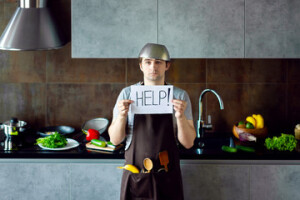Restaurants During COVID-19
by Jan

Every year the trend oracles have a go at predicting what restaurants are going to serve up the following year. Remember fads like acai, kale, cauliflower, kombucha, and plant-based protein?
However, hospitality is not just about fads, food and drinks, it’s also about meeting friends and having a chat and a laugh. Occasionally, this makes a welcome change from your home cooking, which may become tiresome after a while.
Well, this year those predictions and fads went the same way as food scraps. This virus has become the great leveller.
All that normal hospitality has been replaced by restaurants and cafés struggling every day to stay afloat. That means menus have to be cost effective but cheap enough to be attractive for customers to want to return. Suppliers have to be reliable, and if not, chefs have to be nimble and imaginative enough to concoct a dish with what’s left in the cool room.
Behind a plate of food are hidden costs: labour is the biggest, and there’s a tricky balancing act between paying a worker fairly and ethically, and keeping the labour cost percentage down.
A worker also has a life, bills to pay, and probably a family to support, so having a stable roster is fairer than employing people casually. The result is less staff turnover, and stability.
The business owner may like to consider a co-operative or collective ownership model. Ultimately it’s fairer, and the owner is less likely to be denigrated behind his back for not taking the opportunity to change the traditional kitchen culture ie. bullying, racism, sexism, and toxic masculinity.
There has been enough in the press about policies of fairness and inclusivity being more profitable, than the hostile bullying modus operandi. Not only that, the owner is less likely to be hauled up in front of a court, or fined by government agencies for underpayment of wages etc. A bit of thinking never hurt any chef or business owner.
There’s a saying which goes something like ‘never waste a disaster’. It’s an opportunity to change things for the better. For example, buy responsibly produced foodstuffs and change the menu according to the seasons. Seasonal fruit and vegetables are cheaper and plentiful; it makes sense to use them, preferably directly from the market gardeners.
Apart from the labour cost, there is the food cost, which is closely linked with menu pricing. Some cuts of meat, and fish are very expensive even if bought from a wholesaler. It is portioned and along with accompanying ingredients, costed. But sometimes this makes the selling price too high, so there is a juggling act: the prices of the cheaper dishes have to be raised to compensate for the more attractive selling price of the very expensive dishes.
Another issue is the supply chain: further back up the supply chain, community-based farming works a lot better on many levels than broad-acre monoculture crops. But there is sometimes a problem of exploitation of agricultural workers.
There are also the issues of unsustainably caught fish, and animals which come from feed lots.
The owner of the restaurant incurs fixed costs, eg. rent which can be raised on a whim if the landlord perceives the restaurant to be thriving and busy, or not. The other fixed cost is insurance for contents and probably other things.
However, all this has been upended by the Covid pandemic, which has meant that restaurateurs, caterers, suppliers, cooks, and market gardeners have had to change their ways. Hence the expression: ‘never waste a crisis’.
One way chefs can reduce costs is to establish cloud (or ghost) kitchens which have been making an appearance recently. Apart from cooks, the only people who enter are deliverers from organisations such as Uber Eats and Deliveroo. And instead of waiters, all they need is the software to receive orders from these apps.
If lunch and dinner revenue is decreasing, make easy-to-reheat take-away deals for those working at home. Failing that, if the prep kitchen is too expensive to keep open, the chefs could make their meals from home, or pop-ups, using social media to advertise and sell them. And don’t worry about fickle food fads.
A few chefs who have had to close their restaurants have started to use their facilities and skills to cook and produce meals for donation to those who are in precarious circumstances. This is not only helpful for those on the receiving end, but also the chefs gain some reputational advantages. If these out-of-work chefs cook for a charity, that is good for both the chefs’ resumés, the charities they work for, and the recipients of these meals. Collaboration works socially, environmentally, and gives people some hope.
It’s about adaptation and trial, for example, offer Zoom classes on how to cook; offer classes on ideas about how business could increase their lines of business.
The rationale for this is that returning to normal after the pandemic may not happen.
And you never know, it might give policy makers something to do which is efficient, feasible, productive, useful – working towards a real solution to food insecurity.
The policy makers in the UK didn’t do a great job of the Eat Out to Help Out Scheme because it resulted in people crowding together in restaurants and the street outside. The scheme offered restaurant goers 50% discount to eat out on Mondays, Tuesdays and Wednesdays. But it didn’t stop them continuing to eat out the other days in the week. Perhaps what the UK government could have done is to subsidise hospitality businesses with cheap loans, debt relief, tax relief, or payroll subsidies.
Finally, if all else fails, and business owners want to save the world, they could start composting their food waste, and invest in carbon farming.